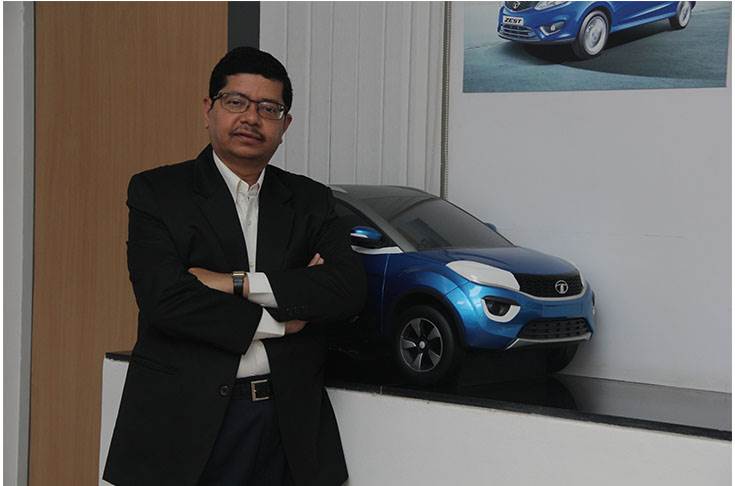Tata Motors, India’s fourth largest passenger vehicle maker, is still some distance away from a podium position in the market. However, it wants to take the lead position when it comes to safety, an attribute it wants to build upon as a key USP for its models as part of its turnaround plan 2.0
“We would like to have the safest car in every segment we offer. With Nexon it started, Altroz (now) and you will see that all the upcoming products will also have safety as differentiating factor” Rajendra Petkar, president & CTO, Tata Motors told Autocar Professional a day after the company’s most recent offering, a premium hatchback, the Altroz secured a 5-star rating for adult occupant safety, in a crash test by international safety watchdog Global New Car Assessment Programme (GNCAP). The only other Indian car to secure a 5-star rating so far is the Tata Nexon.
While the Altroz variant, which Global NCAP tested recorded a strong five-star rating for adult occupant protection and three stars for child occupant protection, Nexon , had in December 2018 scored five stars for Adult Occupant Protection and three stars for Child Occupant Protection thus becoming India’s first five start rated car.

Rajendra Petkar, president & CTO, Tata Motors: ‘We would like to have the safest car in every segment we offer. With Nexon it started, Altroz (now) and you will see that all the upcoming products will also have safety as differentiating factor.’
Altroz is the first model based on Tata’s ALFA platform. Explaining some salient features of the platform, Petkar says the engine bay area and its packaging layout is very important. Number two is the strength of the cabin structure and its load path which provides the safety in case of an impact. Further, if the crash happens, then how are restraints (seat belt, air bags) able to respond? “But then you need to structure everything optimally because it has a high cost structure” Petkar cautions. And that gave Petkar and the team confidence of scoring well in a crash test. “In all humility I must say the (results) are as expected. When we designed the car, we designed for the maximum safety.”
The Altroz will compete against well entrenched players like Maruti’s Baleno and Hyundai’s Elite i20, in a segment that contributes around 12 percent of India’s annual passenger vehicle sales. In a price sensitive market safety wasn’t quite top priority, largely. However, in 2015, the central government announced UN equivalent crash test standards for all cars from October 1, 2019.
Tata Motors, claims that it wants to offer more than what the mandatory regulations. But would consumers pay for that extra safety margin? Petkar explains “If , they (customers) are explained properly the difference between a 5-star and a 2-star car, then I am 100 percent sure people will only like to buy the 5-star car,” before adding that the safety coupled with an affordable price point, is something which people appreciate.
Further Petkar adds that one can’t just sell a car and then charge additional couple of lakh of rupees for safety features as that would act as a deterrent. According to him, it is important in a country like India where road fatalities takes around 1,50,000 lives per year safety has long been the privilege of very few.
Safety in electric vehicles
Tata Motors is also betting seriously in the electric mobility industry. Because of the nature of electric vehicles’ (EV) energy, safety has an additional dimension in them. The ALFA platform will also see EVs based on it, with an electric Altroz being the first.
Petkar said, in a high ambient temperature country like India battery safety will be very important. Everything needs to be designed that it gives right thermal battery performance. “Number two is how do you package the battery and in case of accident what is going to happen? Are there adequate protection? Are the connectors and the wiring harness is properly anchored? With the high tension wired going around, do you have the integrity and the right lay out?” Ketkar explains stressing that the third import point is the vehicle architecture in terms of strength and rigidity of the shell.
Turnaround 2.0
The Tata Motors management led by its managing director Guenter Butshcek expects turnaround plan to materialise in FY2021 as it plans to launch about a dozen cars amidst a leaner organization, pickup in economy and its related activities. The company’s market share in PV segment currently stands at around 5 percent. With a growing awareness level around safety and the company’s bet on it as a key value proposition, will Tata’s journey in the passenger vehicle market get better? The jury is out on that, but its investments on safety seems to be paying off.
Also read: Tata Altroz aces Global NCAP crash test with a five-star rating
/news-national/tata-motors-aims-to-have-the-safest-car-in-every-segments-it-plays-in-45285 Tata Motors aims to have the safest car in every segments it plays in Tata Motors aims to have the safest car in every segments it plays in https://www.autocarpro.in/Utils/ImageResizer.ashx?n=https://www.autocarpro.in/userfiles/414d8cf5-6f7f-4926-80c0-4e733ab7267f.jpg
